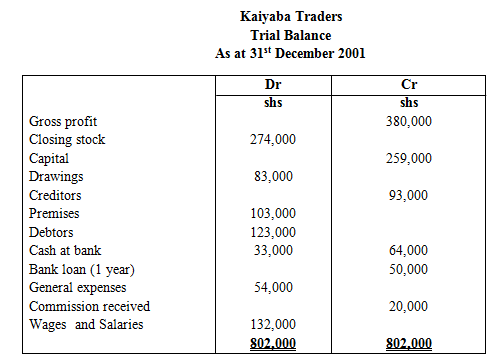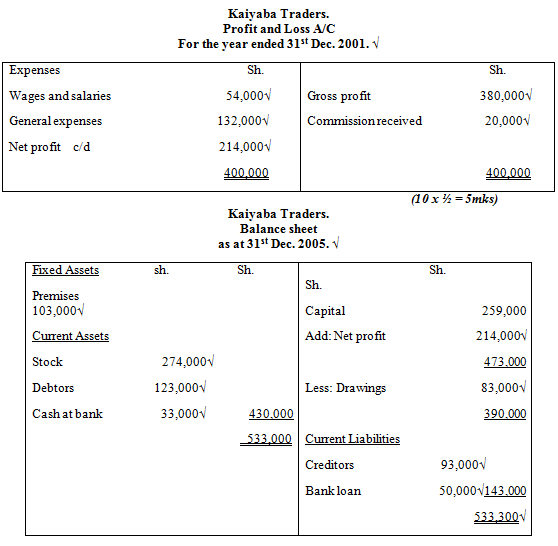Instructions to candidates
- Choose ANY five questions
- All the questions carry equal marks
- All Answers must be written in English
-
- Explain FIVE principles that govern the spending of revenue collected by the government (10 marks)
- The table below represent supply schedule of bread to Kiriaini town.
Year
Quantity of bread
2015
10,000
2016
9,000
2017
7,800
2018
5,000
Assuming the price remains constant, explain five possible reasons for the trend in the supply of bread. (10mks)
-
- Explain five factors to consider when evaluating a business opportunity. (10mks)
- As at 1st August 2012 the cash book of Ongeti showed the following balances:
Cash 10,000, Bank 4,300(Cr)
During the month, the following transactions took place:
August 3: Tumbo a debtor settled his account of Shs. 8,000 by cheque of Shs. 2,500.
August 6: Paid rent by cash Shs. 4,000
10: Deposited Shs. 3,000 into the business bank account from the cash till.
15: Settled Nyamu‘s account in the bank of Shs. 10,000 and be allowed a discount of 1%
21: Cash sales sh. 6,000.
24: Otieno, a debtor, settled his account by a cheque of Shs. 4,000 having been allowed a discount of 20%
26: Purchased furniture Shs. 2,600 paying by cheque.
28: Received Shs. 1,800 cash from Nduta.
30: Banked the available cash except Shs. 800.
Prepare a dully balanced three column cashbook 10mks
-
- explain five benefits enjoyed by a a trader who buys goods on credit rather than by cash (10 marks)
- Explain any five factors that may influence a decrease in the level of national income 10mks
-
- Explain five contributions of commercial banks to the Kenyan economy (10mks)
- Explain five ways in which the efficiency of a warehouse can be enhanced 10mks
-
- Explain five ways in which the government may regulate business activities ( 10mks)
- The following trial balance was extracted from the books of Kaiyaba traders on 31st December 2001
Prepare:- Profit and Loss account for the year ended 31st December, 2001 (5 marks)
- Balance Sheet as at 31st December, 2001 (5 marks)
-
- Explain FIVE features that differentiate a public limited company from a partnership form of business (10 marks)
- The following information relates to Somo Ber Traders for the year 2012.
Capital invested Kshs 1,000,000
Current ratio 3:2
Rate of Stock Turn over 6 times
Turn over Kshs 540,000
Expenses Shs 80,000
Total current Assets Sh 720,000
Total Fixed Assets Shs 960,000
Margin 40%
From the above information determine:- Working Capital (2 mks)
- Gross profit. (2mks)
- Cost of sales. (1mk)
- Net profit. (1mk)
- Average stock (2mk).
- Rate of return on capital. (1mk)
- Total long term liabilities. (1mk)

MARKING SCHEME
-
- Explain FIVE principles that govern the spending of revenue collected by the government (10 marks)
- Sanctions /Authorisation -government spending must be authorized/ approved by the relevant bodies eg. Parliamentary meetings
- Maximum social benefit- govt spending should benefit majority of the citizens equally. Eg. Providing essential services public schools, hospitals.
- Economy- revenue should be used in ways that help avoid wastage ie. Without extravagance
- Elasticity – revenue spending should be flexible to take care of the prevailing economic situations/ emergencies eg. Natural calamities-floods, drought
- Proper financial management- proper records of how revenue is spent should be maintained and auditing regularly done
- Possible reasons for the trend in the supply of bread in Kiriaini town.
- Increase in taxation
- Increase in cost of production
- Decrease in population
- Abolition of subsidies
- Lack of factors of production
- Increase in price of substitutes
- Withdrawal of firms from the industry
(1Mark for stating, 1 mark for explanation, Any 5 x 2 = 10mks)
- Explain FIVE principles that govern the spending of revenue collected by the government (10 marks)
-
- Factors to consider when evaluating a business opportunity
- Personal consideration- abilities and expectations of an entrepreneur which includes Objectives, Skills, Commitments and Interest.
- Availability of markets- an entrepreneur should assess the availability of customers before starting a business
- Technology-the cost and appropriateness of technology should be considered before venturing into the business
- Raw materials- Availability and cost of raw materials in terms of quality and quantity is a major factor to be considered before starting a business. It would be unwise to start a business in a field where raw materials would be a problem
- Government policy- Government policy may determine the success or failure of a business. An entrepreneur should hence consider the government requirements before starting a business for example, the government may require certain types of businesses to be located in certain areas only
- Amount of capital required
- Level of competition
- Security
- Level of development of infrastructure
- Impact of the business operations on the environment
- Three column cash book
- Factors to consider when evaluating a business opportunity
-
- Explain five benefits enjoyed by a a trader who buys goods on credit rather than by cash (10 marks)
- Ownership of goods before full payment is effected
- Enables use/sale of goods before full payment of the goods
- Goods are re-sold thus money earned after sale can be used to clear he debt
- Avails trader with a wider variety of commodities from various manufacturers since he/she buys on credit
- Trader get a chance/opportunity to prove his/her credit worthiness to the supplier
- Factors that may influence a decrease in the level of National Income.
- Inadequate skilled labour, leading to poor quality/ low quantity goods/services generating low income.
- Low level of technology, leading to low output/poor quality goods hence less income.
- Political instability which scares away investors leading to less investment.
- Inadequate foreign investment reducing production of goods.
- Inadequate capital leading to low production hence less income.
- Inadequate natural resources leading to less output hence less income.
- Poor entrepreneurial culture which reduces production hence low income.
- International money orders - issued to consumer to enable them make foreign payments.
- Explain five benefits enjoyed by a a trader who buys goods on credit rather than by cash (10 marks)
-
- Services of commercial banks(5×2=10 marks)(Well explained points)
- Provides means of making payments
- Accepts deposits
- Provides loan facilities to investors
- GIVES foreign exchange SERVICES
- Acts as customers agents in stock exchange\
- Gives financial advice on investments
- Offer trustee services
- Acts as intermediaries between borrowers and savers
- Safekeeping valuable items
- Explain five ways in which the efficiency of a warehouse can be enhanced.
- Encouraging appropriate/proper buildings to suit/match the type of goods to be stored.
- Suitable\appropriate facilities/equipment for effective handling of goods.
- Adequate security to ensure protection of goods (from theft or damage).
- Proper recording system to ensure monitoring of movement of goods in/out of the warehouse.
- Linked to a good/appropriate communication network to facilitate easier contact with clients/suppliers.
- Qualified/skilled/Efficient staff for proper management/functioning of the warehouse.
- Enough spaces to allow easy movement of good/staff.
- Approach transport network to facilitate movement of goods in/out of the warehouse.
- Appropriate/special storage facilities to handle different types of goods.
- Compliant with legal requirements/government policies to avoid conflicts with authorities for smooth operation.
- Suitable location.
- Services of commercial banks(5×2=10 marks)(Well explained points)
-
- ways through which the government can regulate business activities (5×2=10 marks)(Well explained points)
- Licensing - Government requiring all persons operating a business activities acquire a trading license before they start operating.
- Ensuring standards - Government setting standards that business should meet and ensuring the standards are adhered to through KEBS.
- Legisration - (Enacting laws) government setting rules and regulations that regulate business activities.
- Fixing/Setting Quotas - Government setting quantities of goods that should be produced Or consumed.
- Giving guidelines and directiveness- Investors being sometimes guided on areas to establish their business
- Total ban of imports/products. -Government may prohibit certain activities/sales of certain products which are illegal or harmful to consumer’s health.
- Establishing regulatory and law enforcing bodies such as transport and licensing board(TLB), law courts to punish Law breakers.
- Profit and loss a/c and Balance sheet
- ways through which the government can regulate business activities (5×2=10 marks)(Well explained points)
-
- Differencies between a public limited company and a partnership
PUBLIC LIMITED COMPANY
PARTNERSHIP
Membership minimum of 7 shareholders
No maximum membership
Shares are freely transferable without consent of other members
Members have limited liability
Managed by people appointed by a board of directors
Regulated by articles/ memorandum/companies Act
Pay corporation tax
Can sue/ be sued under the name/as a legal entity/ incorporated
Capital raised from sale of shares/general public
Mandatory by law to publish financial statements/ trading results
Has perpetual continuity/death/departure of shareholder doesn’t lead to dissolution
Shares can be quoted/listed in the stock exchange
Sharing of profits is based on members shares
Formation procedures requires long legal formalities
Books of A/c must be audited by (external) auditors
Owned by shareholders
Membership minimum of 2 partners
Maximum of 20 for business/ 50 for professionals/10 for bankers
Shares/capital contribution transfer requires consent of other partners
No limited liability of members/ at least one partner has unlimited liability
Managed by partners themselves/active partners
Regulated by partnership deed/ partnership agreement/articles/partnership act
Doesn’t pay corporation tax
Individual partners can be sued as no legal entity/ un-incorporated
Capital raised from members contributions/partners
Not mandatory by law to publish financial statements/trading returns
Has no perpetual continuity/ death/departure of a partner leads to dissolution
Shares cannot be quoted/listed in the stock exchange
Sharing of profit based on agreement/ equity if no agreement
Formation procedures require short legal formalities
Books of A/c need not be audited by ( external) auditors
Owned by partners
-
- Current ratio = Total Current Assets
Total current Liabilitie
3 = 720000
2 Total current liabilities
Total current liabilities = 480000
Working capital= 720000-480000 = 240000 - Gross profit
Margin = gross profitx100
Sales
Gross profit = 540000x40
100
G.P =216000 - Cost of sales = sales-gross profit
54000-216000 = 324000 - Net profit = Gross profit - Expenses
( 216,000 – 80,000) = 136,000 - Average stock
Rate of Stock Turn Over = Cost of sales
Average stock
6 = 324000
Average stock
Average stock =54000 - Return on capital = net profitx100
Capital invested
= 136000x100
1000000
= 13.6% - Total long term liabilities = total assets- net capital+current liabilities
Total assets = 960000 + 720000 = 1,680000
Net capital = capital invested + net profit = 1000000+136000 =1136000
Current liabilities = 480000
Longterm liabilities = 168000-(1136000+480000) =64000
- Current ratio = Total Current Assets
- Differencies between a public limited company and a partnership
Download BUSINESS STUDIES PAPER 2 - 2019 KCSE KASSU JOINT MOCK EXAMS (QUESTIONS AND ANSWERS).
Tap Here to Download for 50/-
Get on WhatsApp for 50/-
Why download?
- ✔ To read offline at any time.
- ✔ To Print at your convenience
- ✔ Share Easily with Friends / Students




